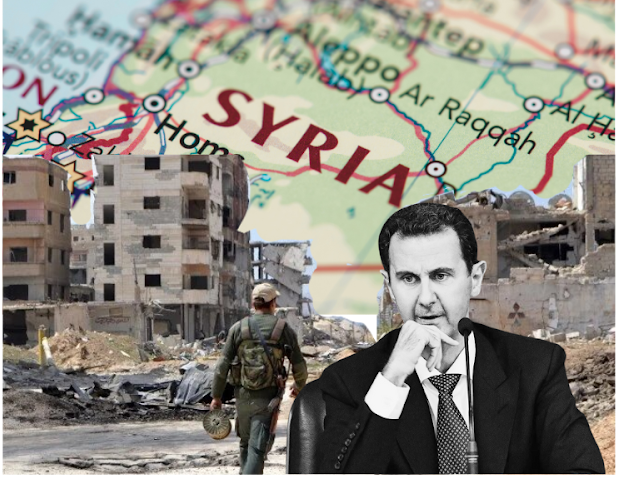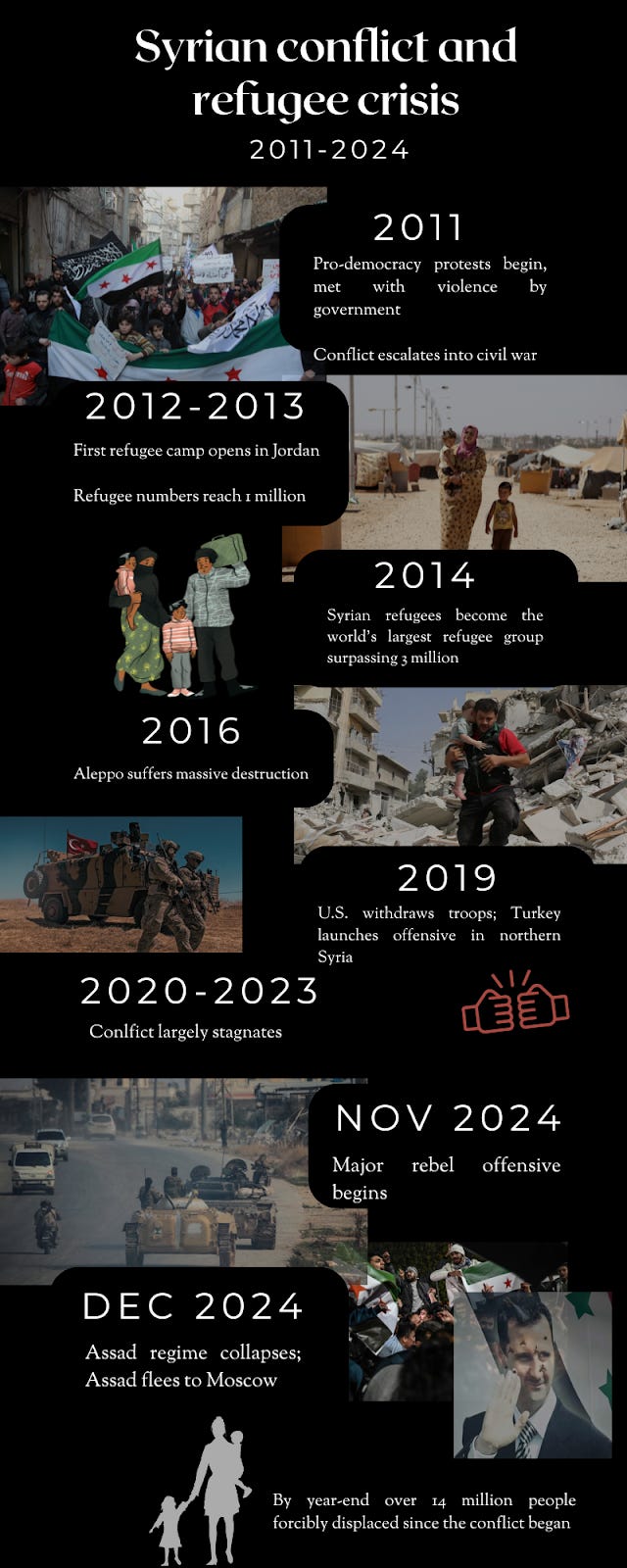Syria’s Long Road to Recovery. After the Fall of Assad.
After the overthrow of the authoritarian government in Syria on December 8, many Syrian refugees are hopeful about returning to their homeland. Yet, after more than a decade of conflict, many have also built new lives elsewhere while Syria’s road to recovery is marked by significant challenges.
At the same time, some European countries are keen to start sending people back to Syria, something the UN refugee agency (UNHCR) has advised against. The UNHCR continues to warn that Syria remains unsafe and calls on states to uphold asylum rights for those fleeing the region.
For those about to return, many questions remain. What conditions will they face upon arrival? And how will these conditions meet – or fail to meet – their basic human needs for safety and security?
End of an Era: Assad’s Fall and What Comes Next
Syria’s history took a turn on December 8 2024 when opposition forces overthrew the authoritarian government that had control over the country for the past 13 years. This marked a significant moment in the conflict in Syria that began in 2011 after protests inspired by the Arab Spring were shut down by violence, escalating into a civil war.
The recent overthrow was led by an Islamist group called Hayat Tahrir al-Sham (HTS). The events unraveled quickly: in just ten days the HTS advanced from the northern province of Idlib to the second largest city of Aleppo, before seizing the capital. As a result of these rapid changes in power, the previous leader, Bashar al-Assad, fled to Russia, ending over 50 years of his family’s rule.
While many Syrians at home and abroad have welcomed the fall of authoritarian rule, there is widespread skepticism about the new situation. It remains unclear how the HTS governance will play out, what will be the sources of funding and the timeline for rebuilding war-torn Syria.
Largest Refugee Crisis in Modern History
Since 2011, the war in Syria has forced 13 million people to flee the country while another 7 million people have been internally displaced. The recent outbreak of the conflict in Lebanon has left half a million people with no option but to return to Syria, putting pressure on the already resource-scarce communities in the country. The large number of people that have been impacted by the conflict in Syria currently makes it the largest refugee crisis in the world.
Now with the transformed political situation, an estimated 1 million refugees are expected to return. However, humanitarian organizations have called for patience from hosting countries as well as consideration for the humanitarian conditions in Syria before beginning the repatriation of refugees.
The safety and security of Syrians is not guaranteed after the fall of the Assad regime. Firstly, many areas such as north east Syria remain targets of physical violence by different groups. Secondly, in areas where fighting has come to an end, the impacts of war on physical infrastructure – houses, roads, and hospitals – are devastating. Rebuilding these areas will be challenging, since the Syrian economy has been weakened by the conflict and international sanctions.
Destroyed Homes
13 years of war have left Syria’s civilian infrastructure in ruins. The satellite images below show the impact on Jobar neighbourhood in Damascus, which is one of the worst affected parts of the capital city. The images are from the same neighbourhood, 10 years apart.
2014 2024
Source: ArcGIS Living Atlas
In addition to destruction from bombings, many homes have been confiscated by the former government under a controversial 2018 law. Through this legislation, authorities were given the right to seize private properties if the owner was not able to provide documented proof of ownership. With millions of Syrians living abroad, claiming their homes was practically impossible, meaning that they today have no homes to return to.
Devastated Infrastructure and Services
Syria’s infrastructure has been devastated by years of war, with urban areas like Homs, Aleppo, and Damascus among the worst affected. Many roads in these cities remain blocked and public buildings – including schools, offices, and places of worship – have been damaged. The reconstruction of these urban areas is complicated by conflict debris that has been left behind due to the destruction of buildings.
Medical facilities continue to face severe challenges. Hospitals and clinics have been damaged or destroyed, leaving many Syrians without access to essential care. The collapse of the healthcare system has had serious consequences, including the spreading of infectious diseases. According to World Health Organization, extensive repairs and investments are currently needed to restore even basic levels of service delivery in hospitals.
The destruction extends to water infrastructure, worsening public health challenges. Water resources have been weaponized in the conflict, which has led to widespread water scarcity. Bombed water treatment plants and pipelines have left many areas without access to safe drinking water, leading to sanitation issues and increasing the risk of disease outbreaks. This has been exacerbated by climate change, with droughts adding a further strain on an already fragile system.
Environmental Challenges
Syria’s environment has been one of the silent victims of the long-standing conflict. The conflict has exacerbated issues such as air pollution, deforestation, and soil erosion in Syria. Years of war have disrupted ecosystems, creating long-term consequences for natural ecosystems and human livelihoods.
Air pollution levels remain high in many areas. Explosions and burning waste in war zones have released toxic chemicals into the air and groundwater, putting the health of local communities at risk.
In February 2023, Syria was further devastated by a powerful earthquake, which caused immense humanitarian losses. Tens of thousands of homes were destroyed, and northern and western Syria remain deeply affected. Rebuilding efforts in these areas have been complicated by the politicization of humanitarian aid. The Syrian government’s discriminatory response neglected regions outside its control, leaving many communities without the resources needed to recover.
The Decline of Agriculture
Agriculture used to flourish in Syria, with farming providing livelihood for millions. But over a decade of conflict has left its impact: destroyed irrigation systems, severe droughts, and a lack of water have left much of the farmland unworkable. This has meant loss of employment for many Syrians, especially in rural communities.
For refugees returning to Syria, this poses a serious challenge. Farmland they once relied on may now be unusable, and resources to restart farming are limited. Without major efforts to rebuild agricultural infrastructure, many Syrians will find it difficult to rebuild their lives.
The Dangers of a 'Swift Return'
In a meeting with the UN envoy, the HTS leader Al-Shara promised to support a swift and safe return for Syrian refugees. This seems to align with the interest of some host-countries for Syrian refugees, a German politician recently suggesting that Syrians could be given 1000-euro checks to incentivize them repatriate. However, as many humanitarian organizations have pointed out, such quick conclusions of returning refugees might put their safety in risk.
While the Syrian conflict may now have come to an end, the material conditions for safety and security remain dire for returning refugees. After four years of frozen conflict, Syria’s reconstruction is barely beginning, as it has been held back by political, economic, and logistical barriers.
A Long Road Ahead
While the fall of Assad’s regime marks a turning point for Syria, the road to recovery is long and uncertain. Before the establishment of clear governance, the rebuilding of the war-torn nation can not effectively begin. The war in Syria has had a destructive impact in all areas of life and society. The reconstruction of Syria has seen little momentum over the past years, with much of the country still grappling with the aftermath of war. These things continue to shape the possibilities of Syrians to return home, now and in the years to come.
In this episode Marianne discusses the issues Syria will face in the post Asad world. She is a student journalist with us on a placement organised with Oxford University Career Services. This article was edited using Lex.page.
Thank you for reading an A4R 🎨 Post. Don’t forget to visit our gift shop here. Every purchase scales our impact and pays our bills.
















